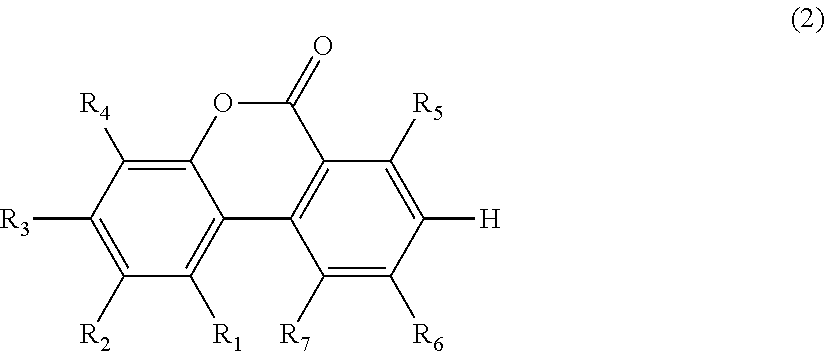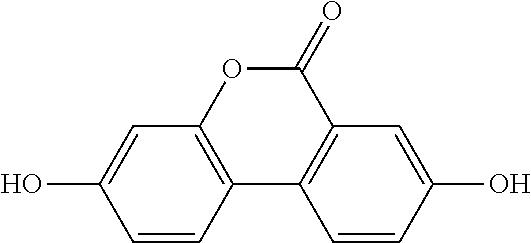Method for producing urolithins
a technology of urolithin and urolithinase, which is applied in the field of urolithin production, can solve the problems of inability to produce ellagic acid metabolites in human, inability to use chemical synthesis methods to achieve the effect of using urolithins as functional foods, and inability to produce ellagic acid metabolites,
- Summary
- Abstract
- Description
- Claims
- Application Information
AI Technical Summary
Benefits of technology
Problems solved by technology
Method used
Image
Examples
example 1
Production of Isourolithin A from Urolithin C
[0231]10 mL or ABB medium (manufactured. by Oxoid
[0232]Limited) containing 0.8 g / L of urolithin C was heat-sterilized by autoclaving at 121° C. for 15 minutes, and the gas phase was replaced with N2:CO2:H2 (80% / 10% / 10%) gas. To this medium, the Slackia heliotrinireducens DSM 20476 strain was inoculated, and anaerobic culture was performed at 37° C. After completion of the culture, the same amount of ethyl acetate was added to 5 ml of the culture liquid to extract urolithin, and the resulting ethyl acetate phase was concentrated under reduced pressure, followed by drying. The thus obtained dried product was redissolved in 0.5 ml of methanol, and quantitative analysis of urolithin was carried out by HPLC.
[0233]The HPLC was carried out under the following conditions. Urolithins manufactured by DALTON PHARMA, after dissolution in DMSO, were used as standard samples. As a result of 2 weeks of the culture, as shown in Table 2, isourolithin A wa...
example 2
Production of Isourolithin A from Ellagic Acid
[0239]Into ABB medium (manufactured by Oxoid Limited) containing 1.0 g / L ellagic acid, the Slackia heliotrinireducens DSM 20476 strain, and the Gordonibacter pamelaeae DSM 19378 strain, the Gordonibacter urolithinfaciens DSM 27213 strain or the Gordonibacter faecihominis JCM 16058 strain were inoculated, and culture was performed in the same manner as in Example 1. As a result of 4 days of the culture, as shown in Table 3, isourolithin A was obtained. at molar yields of 62.3%, 55.9%, and 7.4%, respectively, with respect to the ellagic acid added.
TABLE 3SubstrateProductEllagicIsourolithin MicroorganismAcidASlackia1.0 g / L0.469 g / Lheliotrinireducens(molar yield, 62.3%)DSM 20476 strainandDSM 19378 strainSlackia1.0 g / L0.422 g / Lheliotrinireducens(molar yield, 55.9%)DSM 20476 strainandDSM 27213 strainSlackia1.0 g / L0.056 g / Lheliotrinireducens(molar yield, 7.4%)DSM 20476 strainandJCM 16058 strain
example 3
Production of Urolithin B from Urolithin C
[0240]Into ABB medium (manufactured by Oxoid Limited) containing 0.8 g / L urolithin C, the Slackia heliotrinireducens DSM 20476 strain, and the Clostridium bolteae JCM 12243 strain, the Clostridium asparagiforme DSM 15981 strain or the Clostridium citroniae DSM. 19261 strain were inoculated, and culture was performed in the same manner as in Example 1. As a result of 2 weeks of the culture, as shown in Table 4, urolithin B was obtained at molar yields of 0.69%, 0.63%, and 0.46%, respectively, with respect to the urolithin C added.
TABLE 4SubstrateProductMicroorganismUrolithin CUrolithin BSlackia0.8 g / L0.005 g / Lheliotrinireducens(molar yield, 0.69%)DSM 20476 strainandJCM 12243 strainSlackia0.8 g / L0.004 g / Lheliotrinireducens(molar yield, 0.63%)DSM 20476 strainandDSM 15981 strainSlackia0.8 g / L0.003 g / Lheliotrinireducens(molar yield, 0.46%)DSM 20476 strainandDSM 19261 strain
PUM
| Property | Measurement | Unit |
|---|---|---|
| concentration | aaaaa | aaaaa |
| pressure | aaaaa | aaaaa |
| pressure | aaaaa | aaaaa |
Abstract
Description
Claims
Application Information
 Login to View More
Login to View More - R&D
- Intellectual Property
- Life Sciences
- Materials
- Tech Scout
- Unparalleled Data Quality
- Higher Quality Content
- 60% Fewer Hallucinations
Browse by: Latest US Patents, China's latest patents, Technical Efficacy Thesaurus, Application Domain, Technology Topic, Popular Technical Reports.
© 2025 PatSnap. All rights reserved.Legal|Privacy policy|Modern Slavery Act Transparency Statement|Sitemap|About US| Contact US: help@patsnap.com



